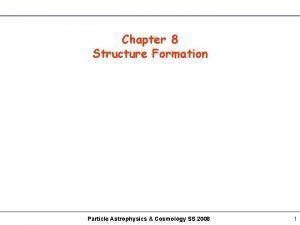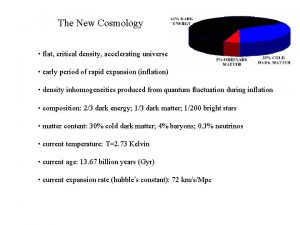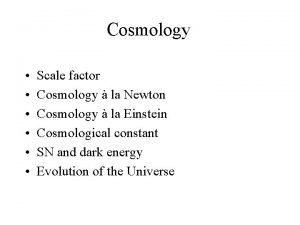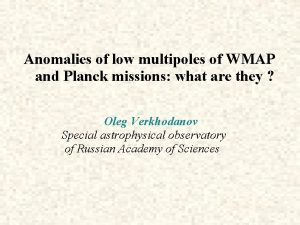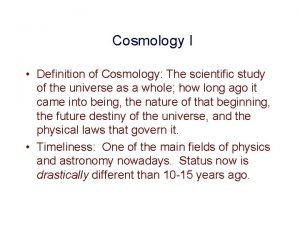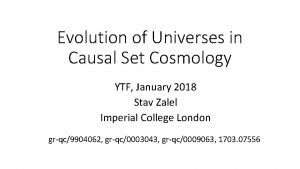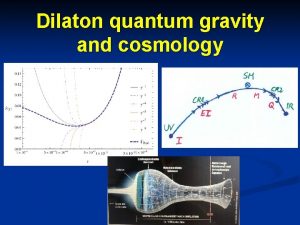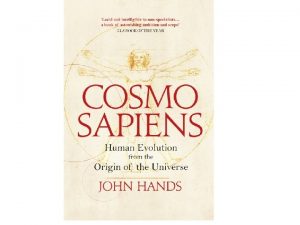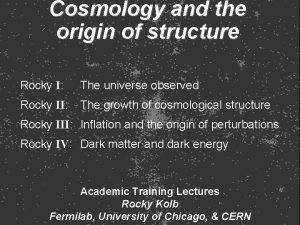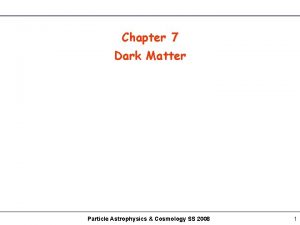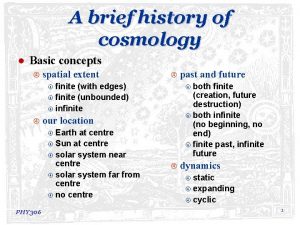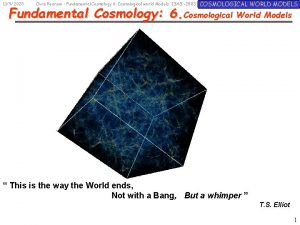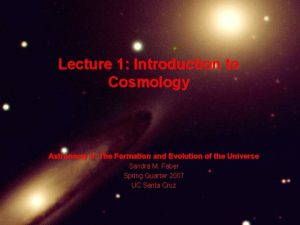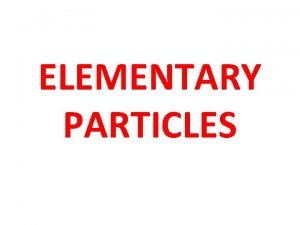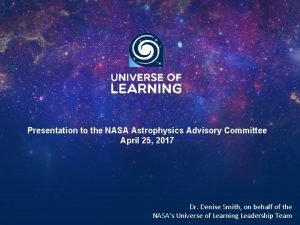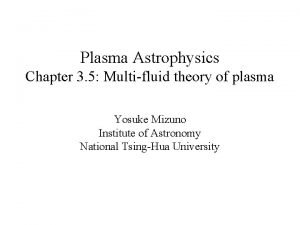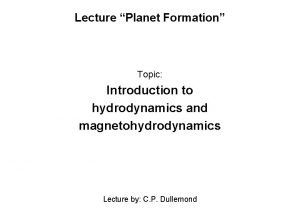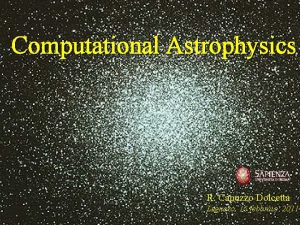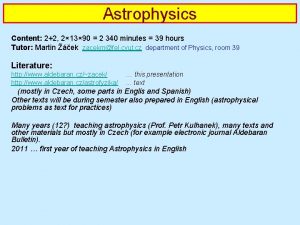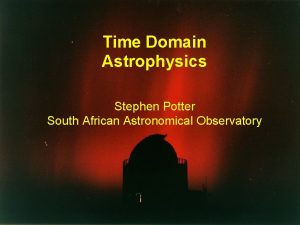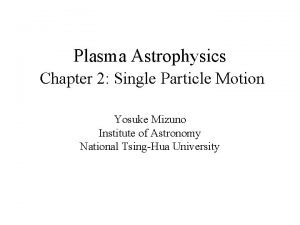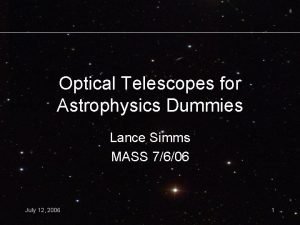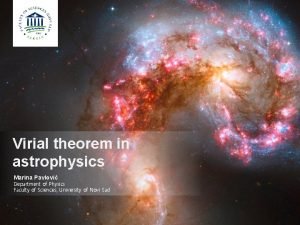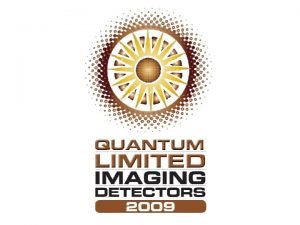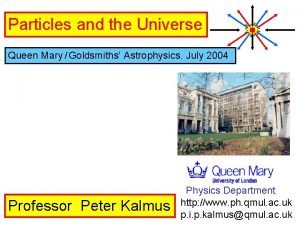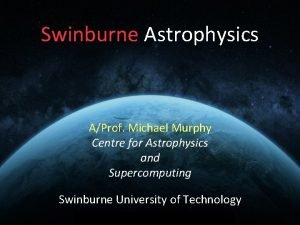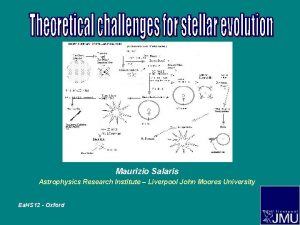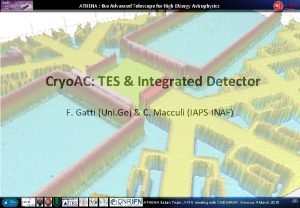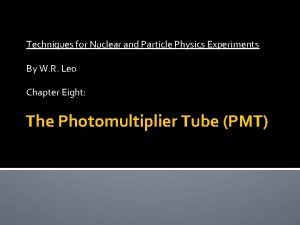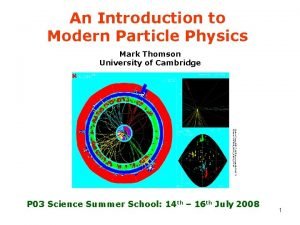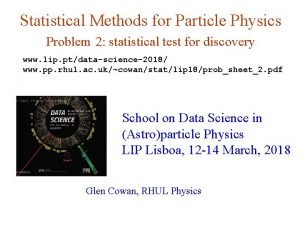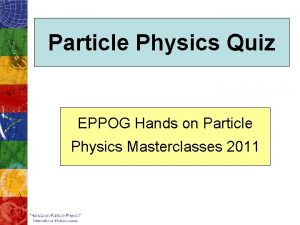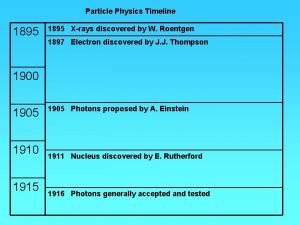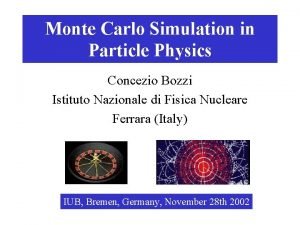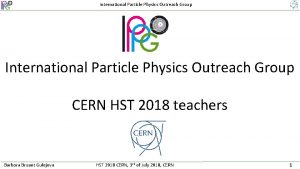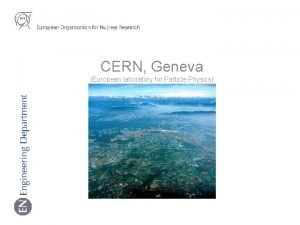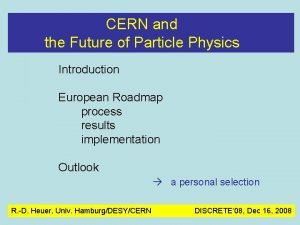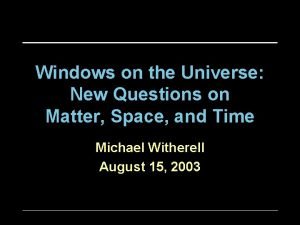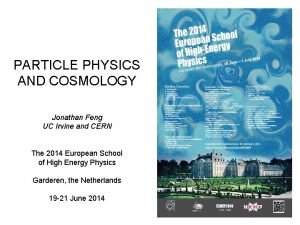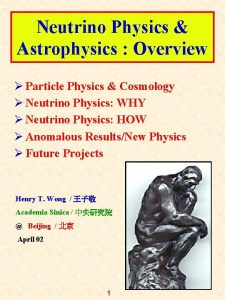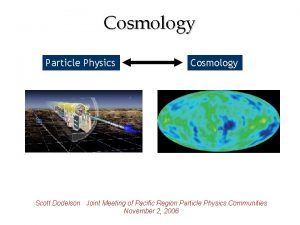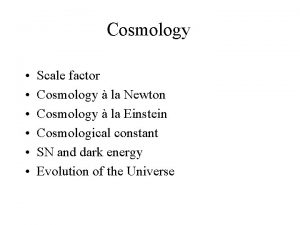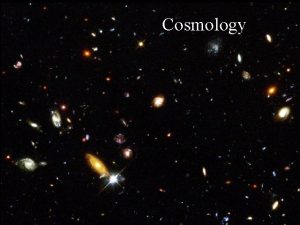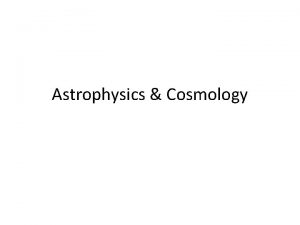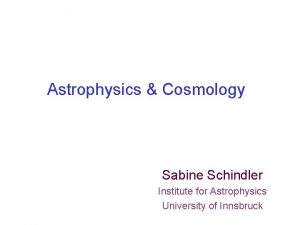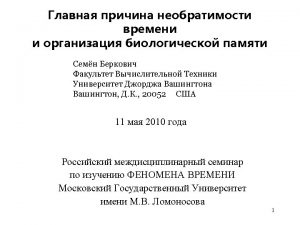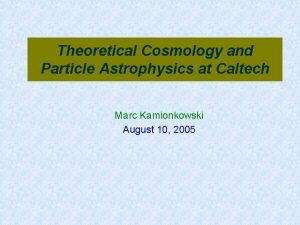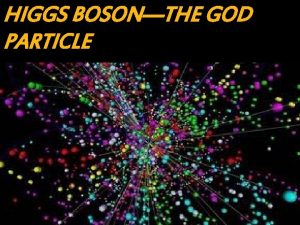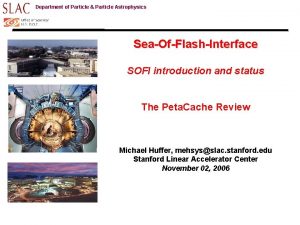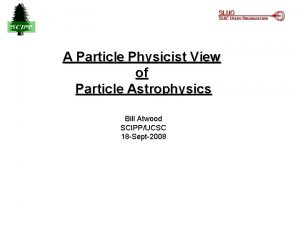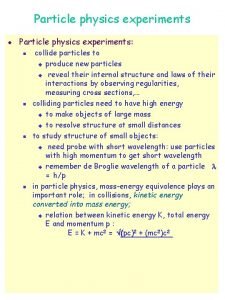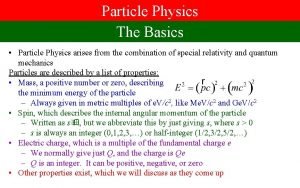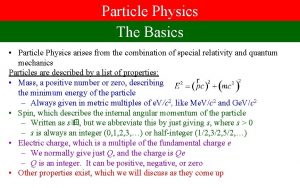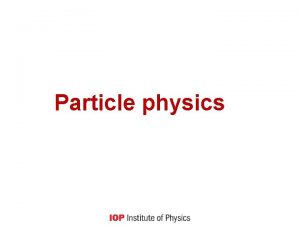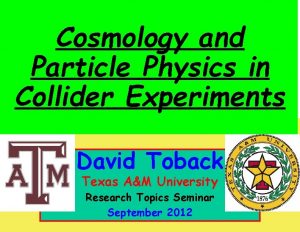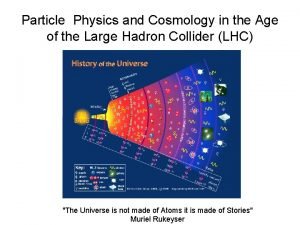Cosmology and Astrophysics and Elementary Particle Physics in







































- Slides: 39

Cosmology and Astrophysics (and Elementary Particle Physics in the 21 st Century) Rocky Kolb

My personal views* • A few generalities • Particle-Astro EPP • EPP Particle-Astro • The role of National Laboratories • Particle-Astro @ Fermilab (illustrates potential and issues) • The world outside of 60510 • Structural questions • What is (and what is not) Particle-Astro? • When does a suite of projects become a program? • How should projects be prioritized & managed? • What is the right slice of Particle Astro in the EPP Pie? * My views are not endorsed by DOE, NASA, NSF, or Fermilab; but they should be.

“When we try to pick out anything by itself, we find it hitched to everything else in the universe. ” – John Muir

A few generalities • Many EPP questions are also Cosmic Questions – Barish/Bagger Report – Physics of the Universe – Beyond Einstein – Quarks to the Cosmos – Quantum Universe • Recognition at the funding agencies – interagency committees and task forces – jointly funded projects • Legacy in nuclear astrophysics • Particle-Astro now expensive enough to be respectable – many projects are too large for a university group or consortium.

Particle-Astro EPP Some historical examples: • Limits on neutrino properties: Nn, mn, tn, mn • Limits on axions from red giants and mass density • First signals of physics beyond standard model – neutrino oscillations (atmospheric, solar) – inflation (physics at mass scale ewk) – non-baryonic dark matter (physics at mass scale ewk? ) – vacuum energy and acceleration (physics at all scales) Possible Futures: • Cosmic rays beyond GKZ cutoff • Mass scale and properties of inflaton potential • Direct or indirect detection of dark matter • Properties of dark matter from clustering • Mass-energy density of the vacuum • Axion detection

Particle-Astro EPP Non Science: Connection to a closely aligned field of science to the public People smaller cheaper faster projects (by EPP standards)

EPP Particle-Astro Some historical examples: asymptotic freedom and T TQCD grand unified theories and inflation proton decay and baryogenesis Nn and nucleosynthesis Higgs mass limits rule out EWK baryogenesis (? ) Phase transitions and topological defects Neutrino oscillations and leptogenesis Possible Futures: SUSY and dark matter Strings and dark energy Higgs mass and baryogenesis/phase transitions Extra dimensions Theory of Everything should tell us something

EPP Particle-Astro Non Science: Experience in large data sets (also space science), e. g. , SDSS in industrial-scale projects, e. g. , Pierre Auger Project People many talented EPP experimentalists to Particle-Astro $$$ Particle-Astro growing part of shrinking budget pie

Relative abundance EPP Particle-Astro Cold Thermal Relics actual freeze out equilibrium T/MX WX s. A-1 (independent of mass)

EPP Particle-Astro Cold thermal relics WX s. A-1

EPP Particle-Astro • SUSY LSP (neutralino) • Direct detection (s. S) More than a dozen experiments • Indirect detection (s. A) Annihilation in sun, Earth, galactic center, subclumps, . . . neutrinos, positrons, antiprotons, g rays, . . . • Production at accelerators (s. P)

EPP Particle-Astro • The details of the relic abundance depend on the details of the SUSY model (spin, co-annihilation, LSP couplings, …) • Low-energy SUSY has more than 100 parameters • Analyses: MSSM, p. MSSM, CMSSM, m. SUGRA, … • Why should dark side be simpler than bright side (Lykken)? • No guarantee that LHC alone will unravel details

EPP Particle-Astro m. SUGRA Ellis et al. , Phys. Lett. B 565 176, (2003)

EPP Particle-Astro • neutrinos (hot dark matter) • sterile neutrinos, gravitinos • LSP (neutralino, axino, …) (warm dark matter) (cold dark matter) • LKP (lightest Kaluza-Klein particle) • axions, axion clusters • solitons (Q-balls; B-balls; Odd-balls, Screw-balls…. ) • supermassive wimpzillas Mass range Interaction strength range axions Noninteracting: wimpzillas axion clusters Strongly interacting: B balls

The Role of National Laboratories • If National Laboratories did not exist, would they be invented for Particle-Astro projects? • Complexity of Particle-Astro projects beyond universities or university consortia • Same role played by NASA centers (Goddard, JPL, …)

Particle Astrophysics @ Fermilab

Particle Astrophysics @ Fermilab • Particle Astrophysics and the Fermilab (EPP) mission • Rules of engagement • Fermilab Particle Astrophysics Projects – Theoretical Astrophysics – Sloan Digital Sky Survey – Pierre Auger Project – Cryogenic Dark Matter Search – Dark Energy Survey – SNAP/JDEM • Particle Astrophysics Center

Particle Astrophysics @ Fermilab Mission statement: Fermilab advances the understanding of the fundamental nature of matter and energy by providing leadership and resources for qualified researchers to conduct basic research at the frontiers for high energy physics and related fields. Fermilab Long Range Plan (May 2004): Fermilab should substantially expand its leadership role in Particle Astrophysics, which provides probes of fundamental physics that complement accelerator experiments.

Particle Astrophysics @ Fermilab Rules of engagement • Participate in projects requiring National Laboratory • Participate in strength • Participate with universities and other labs • Participate where science overlaps with Fermilab mission • Participate when techniques and talents of staff relevant • Participate in the science

Particle Astrophysics @ Fermilab Theoretical Astrophysics Group (since 1983) • Lederman and Schramm Kolb and Turner • Presently 10 -15 theoretical astrophysicists 4 FNAL staff (+1 in September) 4 postdocs 1 Schramm fellow students/users/visitors • Partially (~1/4) funded by a NASA Astrophysics Theory grant • Sinception, over 1000 papers • Goals: science, support of Lab projects, world-wide impact

Particle Astrophysics @ Fermilab Theoretical Astrophysics Group (since 1983) 1. 2. 3. 4. 5. 6. 7. 8. 9. 10. 11. 12. 13. 14. 15. 16. 17. 18. Alex Szalay, Professor Johns Hopkins University Neil Turok, Professor DAMTP, University of Cambridge Andreas Albrecht, Professor University of California, Davis Keith A. Olive, Professor University of Minnesota David Seckel, Associate Professor Bartol Research Institute Lars G. Jensen, Associate Professor North Dakota State Richard F. Holman, Professor Carnegie-Mellon University David P. Bennett, Associate Professor Notre Dame Marcelo Gleiser, Professor Dartmouth College Albert Stebbins, Scientist II Fermilab Edmund J. Copeland, Professor University of Sussex Angela V. Olinto, Associate Professor University of Chicago Dongsu Ryu, Professor Chungnam University, Korea Scott Dodelson, Scientist II Fermilab Ruth A. Gregory, Academic Staff University of Durham David Salopek, Senior Researcher UBC Esteban Roulet, Visiting Professor Valencia, Spain Fay Dowker, Lecturer Queen Mary University of London 19. 20. 21. 22. 23. 24. 25. 26. 27. 28. 29. 30. 31. 32. 33. 34. 35. 36. James Gelb, Assistant Professor UT, Arlington Robert Caldwell, Assistant Professor Dartmouth College Stephane Colombi, Scientist Institut d'Astrophysique, Paris Igor Tkachev, Researcher CERN Andrew Heckler, Assistant Dean, Ohio State University Yun Wang, Assistant Professor University of Oklahoma Istvan Szapudi, Assistant Professor University of Hawaii Antonio Riotto, Professor INFN, Padova Will Kinney, Assistant Professor SUNY Buffalo Lam Hui, Associate Professor, Columbia University Ewan Stewart, Assistant Professor Korea Advanced Inst. Zoltan Haiman, Assistant Professor Columbia University Pasquale Blasi, Faculty Osservatorio Astrofisico di Arcetri Idit Zehavi, Assistant Professor Case Western Reserve Ravi Sheth, Assistant Professor University of Penn Patrick Greene, Assistant Professor UT, San Antonio John Beacom, Assistant Professor Ohio State University Nicole Bell, Assistant Professor, University of Melbourne

Particle Astrophysics @ Fermilab Sloan Digital Sky Survey – E 885 (since 1991) 120 MPix camera • About 150 scientists • Participants University of Chicago Fermi National Accelerator Laboratory Institute for Advanced Study Japan Participation Group Johns Hopkins University Korean Scientist Group (KSG) Los Alamos National Laboratory Max-Planck-Institute for Astronomy/Heidelberg Max-Planck-Institute for Astrophysics/Garching New Mexico State University of Pittsburgh University of Portsmouth, Princeton University United States Naval Observatory University of Washington 640 fiber spectrograph • Funding from Sloan Foundation, DOE, NSF, NASA, USNO, Monbusho, Universities, Max Planck 2. 5 m telescope

Particle Astrophysics @ Fermilab Issue: • Funding from Sloan Foundation, DOE, NSF, NASA, USNO, Monbusho, Universities, Max Planck Particle-Astro projects (like EPP) are international Funding partnership of US government agencies, private, and international Management, oversight issues

Particle Astrophysics @ Fermilab Sloan Digital Sky Survey – E 885 (since 1991) • Its 5 -year mission: map p steradians in 5 colors, find the redshift of 106 galaxies and 200, 000 quasars • Understand the role of dark matter in shaping structure • Today: imaging 100%; spectro 70% • Metric of success: SDSS-II: Sloan and NSF ($5. 4 M) – Legacy (extend SDSS-I) – SEGUE (galactic merging) – SN (low/intermediate redshift)

Particle Astrophysics @ Fermilab Pierre Auger Project – E 881 (since 1995) • About 250 scientists • Participants Argentina Italy Australia Mexico Bolivia Poland Brazil Slovenia Czech Republic Spain France United Kingdom Germany USA Greece Vietnam 1600 surface detectors Hybrid scheme UCLA Michigan Tech Case Western Minnesota Chicago Nebraska Colorado New Mexico Colorado State Northeastern Columbia Ohio State Fermilab Argonne Utah Louisiana State • Funding from DOE & NSF US ~ 25% & 13 agencies abroad • URA manages 24 fluorescence detectors

Particle Astrophysics @ Fermilab • Its mission: spectrum, source, and composition of highest energy cosmic rays • Already world’s largest array - 30, 000 km 2 of pampas in Argentina • Build, calibrate, take data, interpret • 38 papers at ICRC Still bugs Pierre Auger Project – E 881 (since 1995)

Particle Astrophysics @ Fermilab Issues: • About 250 scientists • Funding from DOE & NSF US ~ 25% & 13 agencies abroad Note size Located offshore US not majority support

Particle Astrophysics @ Fermilab Cryogenic Dark Matter Search – E 891 (since 1996) • About 50 scientists • Participants Fermilab LBNL Brown Minnesota Stanford UC Santa Barbara Case Western Reserve Colorado (Denver) Santa Clara UC Berkeley Caltech Florida • Funding from DOE & NSF Located in Soudan mine (co-located w/ MINOS)

Particle Astrophysics @ Fermilab Cryogenic Dark Matter Search – E 891 (since 1996) • Its mission: direct detection of dark matter DAMA Na. I/1 -4 3 s region • Best limit in the world by a factor of 4 IN PL ZE • Probing significant regions of MSSM model space • Light-mass region largely ruled out • Another factor of 3 -4 at hand in Soudan W L DE E Combined Soudan limits I S S I E

Particle Astrophysics @ Fermilab Issue: • Another factor of 3 -4 at hand in Soudan What then? Planning for next step in direct detection of dark matter?

Particle Astrophysics @ Fermilab New Initiatives Dark Energy Survey: • 5000 deg 2 survey of the southern galactic cap • constrain w to ~ 5%, begin to constrain dw/dz • CTIO Blanco 4 -m telescope • 2. 2 deg. FOV camera $22. 5 M • 2005 -2009 Construction • 2009 -2014 Operations SNAP (JDEM): • Joint NASA/DOE dark energy space mission • Lot of action, little money • R&D lead by LBNL • Fermilab admitted to SNAP in 2004 On the horizon: • Auger North • Super. CDMS

Particle Astrophysics @ Fermilab Issues: How do we (FNAL) plan future initiatives? Is our suite of projects optimal?

Particle Astrophysics @ Fermilab Goals • Intellectual center to unify and focus the astrophysics program, enhance effectiveness and recruiting power • Framework to germinate, develop, advance future efforts • Internationally recognized center for Particle Astrophysics • Interdivisional • Membership open to all Fermilab employees working on existing astrophysics projects and new initiatives • Assist Users community involved in Center programs

The world outside of 60510 • Exciting Particle-Astro projects where Fermilab is not involved ICE 3, LSST, Veritas, CMB, GLAST, … • All have some of the issues of FNAL projects • Some have unique issues • One size does not fit all

Define Particle Astro • The grey area • “I know it when I see it. ” Particle. Astro

Projects Program • There is no roadmapping procedure for Particle-Astro • There are many great projects, does this make a program? • Is it perceived as a coherent program or mishmash of projects?

Management and Priorities • Particle-Astro program is diverse (great strength, but…). • There is no Particle-Astro PAC! • Connecting Quarks with the Cosmos did not prioritize • Will Eleven Science Questions for the New Century be revisited? • How to set balance accelerator vs. other

The Particle-Astro Slice • Remarkable time in Particle-Astro: Auger, Ice 3, JDEM, LSST, CDMS, SDSS, Veritas, WMAP, Planck, GLAST, …, DON’T FORGET THEORY! • EPP contribution has been substantial • Money is the limitation for number of projects (true for EPP? ) • Particle-Astro could consume much larger fraction of EPP people and budget – MOS (Auger North, Super. CDMS, LSST, JDEM, …) – Gravitational Wave Physics (LISA, LIGO, …) – Stronger presence in space science (Con-X, CMBPOL, …) – Next generation telescopes (TMT, GMT, …) • How should proper balance be set?

The Particle-Astro Slice • Balance should be set by science opportunities astro & nonaccelerator • Balance must be set by budget opportunities • Must be able to change dynamically • Need realistic science-driven priorities (revisited periodically) • ILC is the 1000 -kg gorilla
 Cosmology
Cosmology Critical density
Critical density Scale factor cosmology
Scale factor cosmology Tomislav prokopec
Tomislav prokopec Definition of cosmology
Definition of cosmology Stav zalel
Stav zalel Dilaton
Dilaton Concordance model of cosmology
Concordance model of cosmology Cosmology
Cosmology Cosmology
Cosmology Newton cosmology
Newton cosmology Cosmology
Cosmology Intro to cosmology
Intro to cosmology Jain geography universe
Jain geography universe Classification of elementary particle
Classification of elementary particle Working with models
Working with models Astrophysics equations
Astrophysics equations Astrophysics equations
Astrophysics equations Astrophysics
Astrophysics Astrophysics syllabus
Astrophysics syllabus Time domain astrophysics
Time domain astrophysics Astrophysics
Astrophysics Astrophysics for dummies
Astrophysics for dummies Virial theorem in astrophysics
Virial theorem in astrophysics Rit astrophysics
Rit astrophysics Queen mary astrophysics
Queen mary astrophysics Swinburne astrophysics
Swinburne astrophysics Maurizio salaris
Maurizio salaris Advanced telescope for high energy astrophysics
Advanced telescope for high energy astrophysics Pmt particle physics
Pmt particle physics Modern particle physics mark thomson
Modern particle physics mark thomson Particle physics
Particle physics Particle physics practice quiz
Particle physics practice quiz Particle physics timeline
Particle physics timeline Monte carlo simulation particle physics
Monte carlo simulation particle physics Cern particle physics
Cern particle physics European laboratory for particle physics
European laboratory for particle physics Cern particle physics
Cern particle physics Particle physics
Particle physics Form factor particle physics
Form factor particle physics
